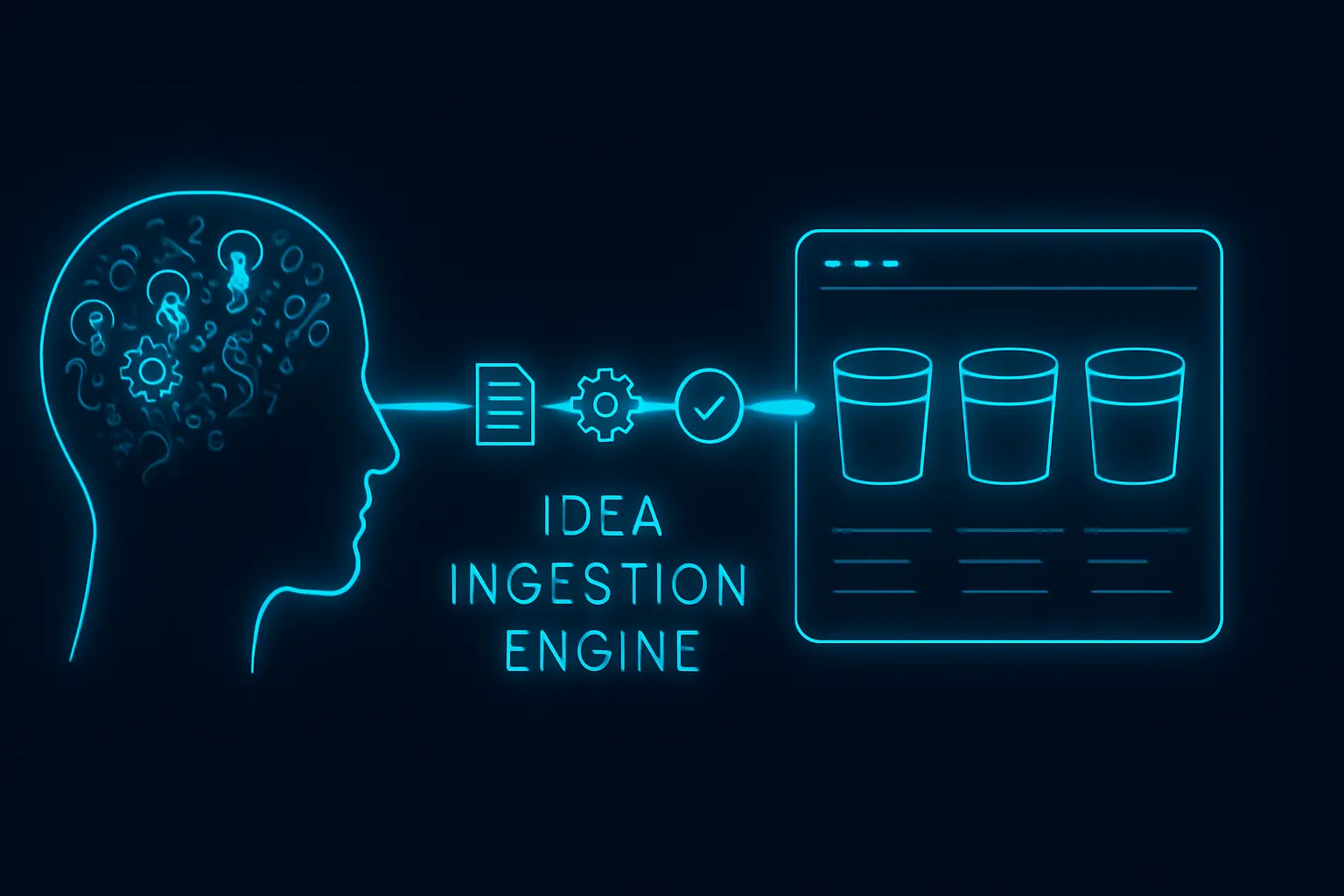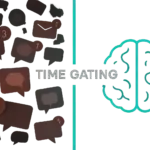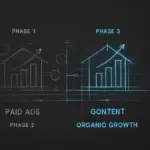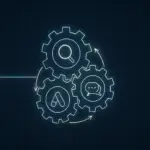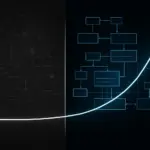I was midway through a drive to one of our JvG Technology facilities when it hit me—a simple, elegant solution to a nagging UI problem in a marketing automation sequence we were building at Mehrklicks. It was one of those rare, perfectly formed ideas. By the time I arrived an hour later, the core of it was gone. I could remember the problem, but the specifics of the solution had dissolved back into the mental noise of the day.
This isn’t a unique experience for founders, or for anyone else trying to build things. Our brains are idea generators, but they are notoriously poor storage devices. The real cost isn’t just the lost idea; it’s the mental energy we spend trying to hold onto it. Research shows that switching contexts—like pausing deep work to jot down a note and then trying to get back on track—can cost up to 23 minutes of focused time. Every „great idea“ that interrupts your flow comes with a hidden cognitive tax.
That’s why I stopped relying on my brain as a storage drive. Instead, I built a system—an „Idea Ingestion Engine“—to offload thoughts frictionlessly, process them automatically, and route them into a structure where they can become valuable assets instead of mental burdens.
The Hidden Tax on Uncaptured Ideas
Before I lay out the system, it’s helpful to understand the problem it solves. It’s rooted in a psychological principle known as the Zeigarnik effect, which states that our brains are hardwired to remember unfinished or interrupted tasks better than completed ones. To your subconscious, an uncaptured idea is an unfinished task. It lingers, consuming precious mental RAM and contributing to a constant, low-level hum of anxiety.
Every time you tell yourself, „I need to remember this,“ you’re creating one of these open loops. The more loops you have running, the higher your cognitive load, and the less capacity you have for the deep, focused work that truly moves projects forward. The goal isn’t to have more ideas; it’s to create the bandwidth to properly execute on the best ones.
My solution was to stop treating ideas as items to be remembered and start treating them as data to be processed. This shift required a trusted, external system to handle the entire lifecycle of a thought.
Building an External Brain: The Idea Ingestion Engine
My engine is designed around three core principles: frictionless capture, automated processing, and structured organization. The entire workflow is built to get an idea out of my head and into a trusted system in seconds, with almost zero disruption to my current task.
Here’s a high-level overview of the data flow:
This simple-looking flow is powerful because it outsources the weakest links in the creative process—memory and manual organization. It’s a micro-example of the same logic I apply when building scalable systems for my businesses: identify bottlenecks, automate them where possible, and create a clear structure for everything else.
My Three-Step Workflow: From Voice to Value
The system itself is surprisingly simple and relies on connecting a few specific tools. This isn’t just a collection of apps; it’s a carefully considered part of designing your digital infrastructure to serve your workflow, not the other way around.
Step 1: Ubiquitous Capture (The Voice Note)
The entry point for any idea—whether it’s a marketing concept, a system tweak for JvG Labs, or a note for a blog post—is a voice note. Why voice? Because it’s the lowest-friction method of capture available. I can do it while driving, walking, or working out. There’s no need to stop, find a pen, or even look at a screen.
I have a dedicated, one-tap shortcut on my phone that immediately starts recording and sends the audio file to a designated processing point. Ultimately, capturing an idea should be as effortless as having the idea itself.
Step 2: Automated Transcription (The AI Bridge)
This is where the magic happens. The raw audio file is automatically picked up by an AI transcription service (like OpenAI’s Whisper). Within a minute, the audio is converted into clean text.
This step is critical because it transforms unstructured, hard-to-search audio into structured, usable text—all without any manual intervention. This is a perfect example of what I explore in my founder’s guide to automation: leveraging technology to handle repetitive, low-value tasks. The transcribed text is then automatically sent to a central inbox in my Notion database.
Step 3: Structured Routing (The Notion Database)
All transcribed notes land in a single „Inbox“ view in my Notion database. This is my central clearinghouse. Once a day, typically in the morning, I spend about five minutes processing this inbox. This isn’t about doing the tasks; it’s about clarifying and routing them.
Each idea is tagged with three key properties:
- Status: Is it an Inbox item (new), Processing (I’m thinking about it), Active (part of a current project), or Archived?
- Type: What kind of idea is it? A Content Idea, Project Tweak, System Improvement, Business Concept, or a Personal Note?
- Context: Which project or area of life does this relate to? JvG Technology, Mehrklicks, Iberosattel, Personal, etc.
This quick triage process turns a random thought into a structured piece of data. A vague voice note like „think about using a different CTA on the landing page“ becomes a tagged item: Status: Active, Type: Project Tweak, Context: Mehrklicks. It’s now in the right bucket, ready to be addressed during my dedicated marketing block, not cluttering my mind while I’m focused on an engineering problem.
Why This System Works: It Frees Your Mind for Deep Work
My Idea Ingestion Engine isn’t about perfectly cataloging every fleeting thought. It’s about giving my brain permission to let go. By having a 100% trusted system for capturing and processing ideas, I’ve eliminated the background anxiety that comes from constantly telling myself „don’t forget this.“
This frees up immense cognitive resources to focus on whatever is right in front of me. The system externalizes the „worrying“ part of the creative process, so I can dedicate my full attention to the „doing“ part. It transforms ideas from interruptions into assets that wait patiently until I’m ready for them.
Frequently Asked Questions (FAQ)
What tools do you specifically use?
While the specific tools can be swapped out, my current stack uses an iPhone shortcut for voice capture. It sends the file to a custom automation that uses the Whisper API for transcription and the Notion API to create a new database item. You can achieve a similar result with apps like Drafts or by simply using a dedicated voice memo app and a service like Zapier or Make.com.
Isn’t this overkill for just a few ideas?
It might seem so at first, but the system’s value scales with the volume and complexity of your work. For a founder juggling multiple projects, the mental clarity it provides is invaluable. The real benefit isn’t just organizing ideas but reclaiming the mental bandwidth they would otherwise consume.
How often do you process your inbox?
Once a day, for 5-10 minutes. Any more than that, and the processing itself becomes a distraction. The point is to batch-process the administrative task of organization so it doesn’t interrupt creative or strategic work.
What if an idea is urgent?
The system is for non-urgent thoughts. If something is truly urgent and important, it bypasses this engine and is dealt with directly. This system is designed to prevent non-urgent things from feeling urgent just because you’re afraid of forgetting them.
Start Building Your Own Engine
You don’t need a complex AI-powered setup to begin. The first and most important step is choosing a single, trusted capture tool. It could be a specific notebook, a notes app, or even a dedicated WhatsApp chat with yourself.
Start by capturing every idea that comes to mind for one week. At the end of the week, review what you’ve collected. The simple act of externalizing your thoughts will likely bring an immediate sense of clarity. From there, you can begin to build the other pieces of your own ingestion engine, one step at a time. The goal is progress, not perfection.
